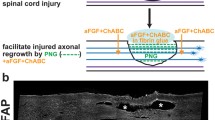Summary
The effect of puromycin on spinal cord regeneration was studied following implantation into the site of spinal cord hemi- or transection of Gel-foam saturated with puromycin (1mM) in a saline carrier, implantation of Gel-foam sponge saturated with saline (carrier control), or lesion alone (lesion control). The spinal cords of 107 rats were studied with light and electron microscopy 7, 14, 30, 60 and 90 days postoperative (DPO). Spinal cord hemisected animals developed a dense cicatrix at the site of lesion replete with connective tissue, blood vessels, and myelinated and unmyelinated nerve fibres which could be traced to peripheral sources. Rostrally at the C.N.S.-cicatrix interface, there were reactive neuroglial cells, occasional nerve fibres and finger-like projections of spinal cord (due to cavitation lesions) which contained neuroglia, axons and dendrites. Implantation of saline in Gel-foam resulted in the same morphology as in hemisected animals except for increased lesion size due to mechanical factors and decreased cicatrix density during the first 30 DPO. Puromycin treatment resulted in a cicatrix with initial decreased cell density but which contained a new class of nerve fibres at 30 DPO. These nerve fibres were oriented in a rostro—caudal direction, were unmyelinated, 0.1–0.2 μm in diameter and had expanded smooth endoplasmic reticulum. Some of these nerve fibres were degenerating at 30 DPO and all were absent by 60 DPO. The puromycin-treated spinal cord within 200 μm rostral to the basal lamina contained nerve terminal conglomerates, which resembled boutons, in fascicles from 30–90 DPO (duration of experiment). Hemisection of the spinal cord by crushing 1-11/2 segments rostral to the site of puromycin implantation at 30 DPO resulted in degeneration of these nerve fibres in the cicatrix as well as the degeneration of nerve terminal conglomerates just rostral to the basal lamina. The regenerative capacity of the spinal cord is discussed in relationship to these findings.
Similar content being viewed by others
References
Barondes, S. H. (1970) Cerebral protein synthesis inhibitors block long-term memory.International Review of Neurobiology 12, 177–205.
Bernstein, J. J. andBernstein, M. E. (1969) Ultrastructure of normal regeneration and loss of regenerative capacity following teflon blockage in goldfish spinal cord.Experimental Neurology 24, 538–57.
Bernstein, J. J. andBernstein, M. E. (1971) Axonal regeneration and formation of synapses proximal to the site of lesion following hemisection of the rat spinal cord.Experimental Neurology 30, 336–51.
Bernstein, J. J. andBernstein, M. E. (1973) Neuronal alteration and reinnervation following axonal regeneration and sprouting in mammalian spinal cord.Brain Behavior and Evolution 8, 135–61.
Bernstein, J. J. andBernstein, M. E. (1976) Ventral horn synaptology in the rat.Journal of Neurocytology 5, 109–23.
Bernstein, J. J. andGoodman, D. C. (1973) Neuromorphological plasticity.Brain Behavior and Evolution 8, 1–164.
Bernstein, J. J., Gelderd, J. andBernstein, M. E. (1974) Alteration of neuronal synaptic complement during regeneration and axonal sprouting of rat spinal cord.Experimental Neurology 44, 470–82.
Bernstein, J. J., Wells, M. R. andBernstein, M. E. (1975) Dendrites and neuroglia following hemisection of rat spinal cord: effects of puromycin.Advances in Neurology 12, 439–51.
Bernstein, J. J., Wells, M. R. andBernstein, M. E. (1978) Spinal cord regeneration and axonal sprouting in mammals. In:Physiology and Pathobiology of Axons (edited byWaxman, S.), pp. 407–20. New York: Raven Press.
Bernstein, M. E. andBernstein, J. J. (1973) Regeneration of axons and synaptic complex formation rostral to the site of hemisection in the spinal cord of the monkey.International Journal of Neuroscience 5, 15–26.
Bernstein, M. E. andBernstein, J. J. (1977) Synaptic frequency alteration on rat ventral horn neurons in the first segment proximal to spinal cord hemisection: An ultrastructural statistical study of regenerative capacity,Journal of Neurocytology 6, 85–102.
Clemente, C. (1964) Regeneration in the vertebrate central nervous system.International Review of Neurobiology 6, 257–93.
Gambetti, P., Gonatas, N. K. andFlexner, L. B. (1968a) Puromycin: Action on neuronal mitochondria.Science 161, 900–902.
Gambetti, P., Gonatas, N. K. andFlexner, L. B. (1968b) The fine structure of puromycin induced changes in mouse entorhinal cortex.Journal of Cell Biology 36, 379–90.
Goldberger, M. E. andMurray, M. (1974) Restitution of function and collateral sprouting in the rat spinal cord: the deafferented animal.Journal of Comparative Neurology 158, 37–54.
Grampp, H., Harris, J. B. andThesleff, S. (1971) Inhibition of denervation changes in mammalian skeletal muscle by actinomycin D.Journal of Physiology 217, 47–8.
Grampp, H., Harris, J. B. andThesleff, S. (1972) Inhibition of denervation changes in skeletal muscle by blockers of protein synthesis.Journal of Physiology 221, 743–54.
Liu, C. N. andChambers, W. W. (1958) Intraspinal sprouting of dorsal root axons.Archives of Neurology and Psychiatry (Chicago) 79, 46–61.
Matinian, L. A. andAndreasian, A. S. (1976) Enzyme therapy in organic lesions of the spinal cord.Brain Information Service, pp. 1–156. University of California at Los Angeles.
McMasters, R. E. (1962) Regeneration of the spinal cord in the rat. Effects of piromen and ACTH upon the regenerative capacity.Journal of Comparative Neurology 119, 113–16.
Murray, M. andGoldberger, M. E. (1974) Restitution of function and collateral sprouting in the cat spinal cord: the partially hemisected animal.Journal of Comparative Neurology 158, 19–36.
Prendergast, J. andStelzner, D. J. (1976a) Increases in collateral axon growth rostral to a thoracic hemisection in neonatal and weanling rat.Journal of Comparative Neurology 166, 145–62.
Prendergast, J. andStelzner, D. J. (1976b) Changes in the magnocellular portion of the red nucleus following thoracic hemisection in the neonatal and adult rat.Journal of Comparative Neurology 166, 163–72.
Ramón, Y. Cajal, S. (1959)Degeneration and Regeneration of the Nervous System. New York: Hafner Publishing Co.
Schmidt, H. andTong, E. (1973) Inhibition by actinomycin D of the denervation-induced action potential in frog slow muscle fibres.Journal of Physiology 184, 91–5.
Torvik, A. andHeding, A. (1969) Effect of actinomycin D on retrograde nerve cell reaction.Acta neuropathologica 14, 62–71.
Windle, W. F. (1956) Regeneration of axons in the vertebrate central nervous system.Physiological Reviews 36, 426–40.
Author information
Authors and Affiliations
Rights and permissions
About this article
Cite this article
Bernstein, J.J., Wells, M.R. & Bernstein, M.E. Effect of puromycin treatment on the regeneration of hemisected and transected rat spinal cord. J Neurocytol 7, 215–228 (1978). https://doi.org/10.1007/BF01217920
Received:
Revised:
Accepted:
Issue Date:
DOI: https://doi.org/10.1007/BF01217920




